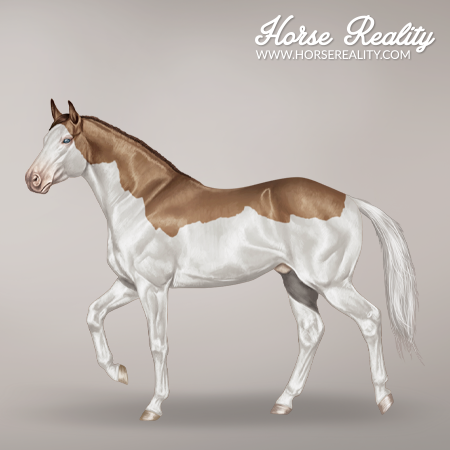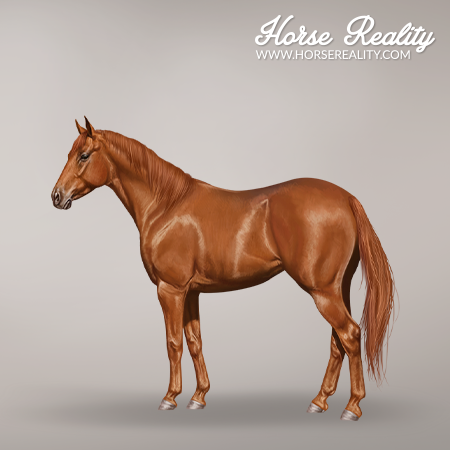The Quarter Horse is a breed available in the Horse Reality game that can be obtained from the Foundation.
| Quarter Horse | |
|---|---|

|
|
| General Information | |
| Alternative name | American Quarter Horse (AQH) |
| Origin | United States |
| Horse Reality | |
| Colours | Black, Chestnut, Bay, Wild Bay, Seal Brown, Flaxen, Cream, Pearl, Dun, Champagne, Silver |
| Whites | White Markings, Overo, SW1, Roan, W10, Rabicano |
| Not yet in-game | SW2, W20, Appaloosa, PATN1, PATN2, Non-Dun1, Sooty, Grey, SW3 |
| Height | 142 - 170 cm |
| Registry | Quarter Horse Society |
| Alternative names | Quarter, QH |
| Origin | Foundation |
| Status | In-game (2018) |
| Artists | |
| Lineart | D. Grochowska (2023) |
| Greyscale | D. Grochowska (2023) |
| Colours & patterns | D. Grochowska, H. Vasseur (2023) |
¶ Conformation
The American Quarter Horse is a breed with a very specific conformation. The breed's ideal horse is well-mannered, of solid colour, balanced, with structural correctness, and adequate muscling. They should have sweet heads, well-proportioned necks, long, sloping shoulders, deep chests, short backs, strong loins, long croups, and straight legs.[1]
¶ Colour Genetics
Due to the mixed heritage, nearly all colours are present in the breed. The base colours are the most abundant, followed by the cream and dun dilutions. Champagne and pearl are quite rare, and silver is known only in very few families.
While a mixed history resulted in a wide range of colours, the same can be said about white patterns - many of them are present in the breed. However, excessive white patterns and their spreading were very much restricted, as white on a horse's body is undesired. As such, horses with too much white were excluded from registering within the AQHA studbook and removed from the genetic pool. Many of these would eventually be registered with the American Paint Horse registry, where white patterns are welcomed. Nowadays Quarter Horses with white patterns are becoming more common since it's now possible to register an AQH with too much white if both parents are registered AQH horses, and their parentage is confirmed via DNA testing.[1]
¶ Alleles
All alleles available for the breed can be found below highlighted in green. For better clarity, we bolded alleles that impact coat colours (eg. grey G vs non-grey g).
| Base Colours & Modifiers | ||
|---|---|---|
| Extension | Agouti | Grey |
| E, e | A+, A, At, a | g |
| Dilutions | ||||
|---|---|---|---|---|
| Cream-Pearl | Dun | Champagne | Silver | Mushroom |
| CR, prl, n | D, nd2 | CH, ch | Z, z | n |
| White Patterns | |||||
|---|---|---|---|---|---|
| Frame | Appaloosa | PATN1 | MITF | SW2 | KIT |
| OLW, n | lp | patn1 | SW1, n | sw2 | RN, W10, n |
Please note that the table includes hidden agouti alleles (A+, and At).. Besides testable genes, untestable ones are also present: flaxen, rabicano, and white markings (head markings, socks, etc.).
¶ Artwork Updates
The Quarter Horse was added to the game in 2018. Ever since the current Horse Reality version has been online, the breed received/will receive the following updates:
- On 15th February 2023, the breed received new artwork[2]
- The missing genes and alleles will be added to the game through new Foundation horses.[3][4]
¶ Artwork Legacy
If you're curious about what the Quarter Horse looked like before the artwork update or just want to reminisce good, old times - search no more.

|

|

|
This beautiful art was created by very talented artists. Horse Reality is forever grateful for them being a part of its history.
| Artists | |
|---|---|
| Lineart | M. Simon (2014) |
| Greyscale | M. Simon (2014-2016) |
| Colours & patterns | T. van den Berg (2016), Jessy (2018), H. Vasseur |
¶ Breed in Real Life
The Quarter Horse, or American Quarter Horse, is one of the most popular breeds from North America. It was named after its exceptional speed on tracks distancing up to a quarter of a mile.
When Spanish conquistadors discovered the American continents and started to colonise the land, they needed horses for battle, moving heavy loads and conquering ground. As America had no native horses, the conquistadors imported their own, many of which were of Iberian breeding, from Europe. The most important for the development of Quarter Horses were the Spanish Barb, and English breeds. Over the centuries, the descendants of these horses and others that were imported adapted to the new land and became the foundation stock for many American breeds like the Mustang, walking horses, Paints, and Quarter Horses.[5]
¶ References
- American Quarter Horse Association, Official Handbook of Rules and Regulations, 70th edition, 2022
- https://v2.horsereality.com/news/127/community-update-massive-sales-quarter-horses-redo-art-survey-results-art-plans
- https://deloryan.notion.site/Horse-Breeds-Artwork-Genetics-6d0a84be35284b12806976bbb8cc886c
- https://v2.horsereality.com/news/52/community-update-v2-market-postponed-preparing-3rd-foundation-generation-about-breed-redos-new-art-intern-march-background
- AQHA, The History of the American Quarter Horse Breed: https://www.aqha.com/web/aqha/history-of-the-quarter-horse; Access: December 2022